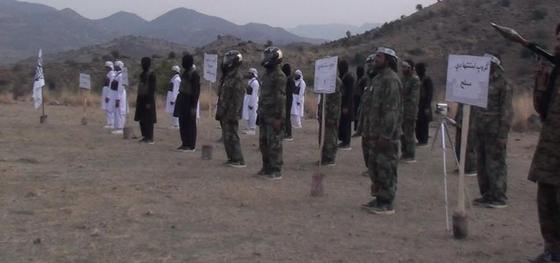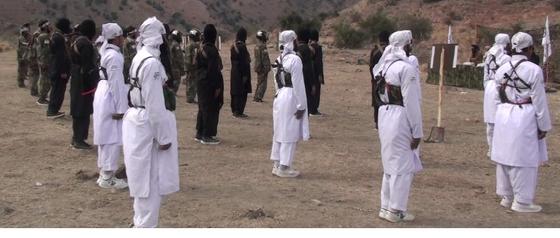
|
| Photographs of the suicide assault teams that struck in Kabul, Paktia, Logar, and Nangarhar on April 15, 2012. Photos from Voice of Jihad. |
The Afghan Taliban have released photos and videos of members of the suicide assault teams that attacked Kabul and the provincial capitals of Paktia, Logar, and Nangarhar earlier this week. The photos were released as the US and Afghan officials have blamed the Haqqani Network, a dangerous Taliban subgroup, for executing the attacks.
The images and videos were released yesterday in the Pashtu and Arabic sections of the Taliban's propaganda website, Voice of Jihad.
The photographs show the Taliban marching and standing in formation. Some fighters are in military uniforms with masks or motorcycle helmets. Others are dressed in white and are wearing suicide vests.
The videos show the fighters sitting in front of a camera and announcing the reasons for carrying out the attack. One of the videos shows a clip of one suicide bomber speaking in English and another bomber speaking in Pashtu.
The Taliban said the fighters carried out the attack to avenge "the two great evil acts of the brutal American forces, one of which is the desecration of the Holy Qur'an by the American soldiers in Bagram air base, and the second is the massacre of Zangawat in Kandahar province," where a rogue US soldier executed 17 civilians in the southern province, according to a transition of the statement by the SITE Intelligence Group.
The Taliban have claimed that more than 220 "NATO-puppet forces" were killed during the assaults that took place on April 15. The Taliban routinely exaggerate the effects of their operations. Afghan officials said that 36 Taliban fighters, 11 Afghan security personnel, and two civilians were killed during the attack.
The videos were released as US and Afghan officials have blamed the attacks on the Haqqani Network, the Taliban subgroup that is closely allied to al Qaeda and is supported by Pakistan's military and its Inter-Services Intelligence Directorate.
One day after the assault, Afghan intelligence officials said a fighter captured in Nangarhar had fingered the Haqqani Network as organizing the attacks. He later said that more than 200 fighters were involved in the attacks, according to Al Jazeera.
Today, Ryan Crocker, the US's Ambassador to Afghanistan, said that "there is no question in our mind that the Haqqanis were responsible for these attacks. We know where their leadership lives and we know where these plans are made," Al Jazeera reported.
"They're not made in Afghanistan. They're made in Miramshah, which is in North Waziristan, which is in Pakistan," Crocker continued, referring to the Haqqani Network's main base in the tribal agency that borders Afghanistan.
The Taliban have released and republished the Haqqani Network's propaganda in the past. In November 2011, the Taliban republished a Haqqani Network video that commemorated its assault on the Intercontinental Hotel in Kabul on June 28, 2011.
